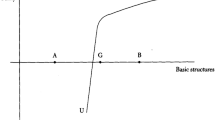Abstract
Various intuitive notions of justice are characterized in terms of geometry. Three approaches to justice (Utilitaran, Rawlsian and Nash) are considered. A set of qualities which we might want a justice approach to have is presented. Three different subsets of these qualities are shown to be uniquely satisfied (out of all possible approaches) by a different one of the three approaches considered.
Similar content being viewed by others
References
Arrow, K.: 1973, ‘Some Ordinalist-Utilitarian Notes on Rawls's Theory of Justice’, J. Philos. 70(9) 245–263.
Barry, B.: 1973, The Liberal Theory of Justice, Clarendon Press, Oxford.
Barry, B. and D. W. Rae: 1975, ‘Political Evaluation’, in N. Polsby and F. Greenstein (eds.), The Handbook of Political Science, Vol. 1, Addison Wesley, Reading.
Blackorby, C. and D. Donaldson: 1977, ‘Utility vs. Equity: Some Plausible Quasi-Orderings’, Journal of Public Economics 7, 365–381.
D'Aspremont, C. and L. Gevers: 1977, ‘Equity and the Informational Basis of Collective Choice’, Review of Economic Studies 46, 199–210.
Deschamps, R. and L. Gevers: 1979, ‘Leximin and Utilitarian Rules: A Joint Characterization’, Journal of Economic Theory 17, 143–163.
Hammond, P. J.: 1976, ‘Equity, Arrow's Conditions and Rawls's Difference Principle’, Econometrica 44, 793–804.
Harsanyi, J. C.:1953, ‘Cardinal Utility in Welfare Economics and in the Theory of Risk-Taking’, Journal of Political Economy 61, 434–435.
Harsanyi, J. C.: 1955a, ‘Cardinal Welfare, Individualistic Ethics and Interpersonal Comparisons of Utility’, Journal of Political Economy 63, 309–321.
Harsanyi, J. C.: 1975a, ‘Non-linear Social Welfare Functions, or Do Welfare Economists Have a Special Exemption from Bayesian Rationality’, Theory and Decision 6, 311–332.
Harsanyi, J. C.: 1975b, ‘Can the Maximin Principle Serve as a Basis for Morality: A Critique of John Rawls's Theory’, American Political Science Review 69, 594–606.
Lyons, D.: 1972, ‘Rawls versus Utilitarianism’, J. Philos. 69(19), 535–545.
Maskin, E.: 1978, ‘A Theorem on Utilitarianism’, Review of Economic Studies 45, 93–96.
Pattanaik, P. K.: 1973, ‘Risk, Impersonality and the Social Welfare Function’, in E. S. Phelps (ed.), Economic Justice, Penguin, Harmondsworth, pp. 298–318.
Phelps, E. S.: 1973, Economic Justice, Penguin, Harmondsworth.
Rae, D.: 1975, ‘Maximin Justice and an Alternative Principle of General Advantage’, American Political Science Review 69, 630–647.
Roberts, K.: 1980, ‘Possibility Theorems with Interpersonal Comparable Welfare Levels’, Rev. Econ. Stud. 47, 409–420.
Sen, A. K.: 1970, Collective Choice and Social Welfare, Holden Day, San Francisco, and Oliver & Boyd, Edinburgh.
Sen, A. K.: 1976, ‘Welfare Inequalities and Rawlsian Axiomatics’, Theory and Decision 7, 242–262; also in R. Butts and J. Hintikka (eds.), Logic, Methodology and Philosophy of Science, Reidel, Dordrecht, 1976.
Sen, A. K.: 1977a, ‘Non-linear Social Welfare Functions: A Reply to Professor Harsanyi’, in R. Butts and J. Hintikka (eds.), Logic Methodology and Philosophy of Science, Reidel, Dordrecht.
Sen, A. K.: 1977b, ‘On Weights and Measures: Informational Constraints in Social Welfare Analysis’, Econometrica 45, 1539–1572.
Strasnick, S.: 1979, ‘Extended Sympathy Comparisons and the Basis of Social Choice’, Theory and Decision 10, 311–328.
Suppes, P.: 1966, ‘Some Formal Models of Grading Principles’, Synthese 6, 284–306.
Thomson, W.: 1981, ‘Nash's Bargaining Solution and Utilitarian Choice Rules’, Econometrica 49, 535–538.
Varian, H.: 1975, ‘Distributive Justice, Welfare Economics and the Theory of Fairness’, Philosophy and Public Affairs 4, 223–247.
Wagner, R. Harrison: 1980, ‘Impartiality and Equity’, Theory and Decision 12, 61–74.
Yaari, M.: 1981, ‘Rawls, Edgeworth, Shapley, Nash: Theories of Distributive Justice Re-examined’, Journal of Economic Theory 24, 1–39.
Author information
Authors and Affiliations
Rights and permissions
About this article
Cite this article
Wittman, D. The geometry of justice: Three existence and uniqueness theorems. Theor Decis 16, 239–250 (1984). https://doi.org/10.1007/BF00134649
Issue Date:
DOI: https://doi.org/10.1007/BF00134649




